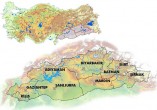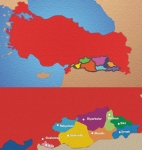Southeastern Anatolia Project (GAP)
Southeastern Anatolia Project (GAP), is the most comprehensive and the costliest project of our republican history, applied the most effectively among other regional development plans and programs prepared so far. GAP is an integrated approach to regional development and sustainable human development in the international literature and philosophy and is a project that has a brand value.
The project area covers Euphrates-Tigris basin and 9 provinces located in the plains of Mesopotamia (Adıyaman, Batman, Diyarbakır, Gaziantep, Kilis, Mardin, Siirt, Şanlıurfa, Şırnak). Total areas and population sizes of provinces within GAP makes approximately 10% of Turkey.
Main objectives of GAP are evaluating the resources owned by the South-eastern Anatolia Region, raising levels of income and quality of life of the local people, resolving disparities between this region and other regions, and contributing to economic development and social stability on a national level by increasing productivity and employment opportunities.
GAP project in the 1970s was considered as a program based on the development of the region’s water and land resources; yielding the plans for irrigation investments in an area of 1,8m hectares with 22 dams and 19 hydroelectric plants for hydroelectric energy production as well as irrigation in the basin of the Euphrates and Tigris. The total installed capacity of energy plants of the  project was 7476 MW meanwhile 27 billion kilowatt-hours of energy production was foreseen.
project was 7476 MW meanwhile 27 billion kilowatt-hours of energy production was foreseen.

GAP was transformed into a regional development project which involved agriculture, industry, transport, education, health and infrastructure in rural and urban areas with the master plan prepared in 1989. The project aimed to develop itself for future generations to create a sustainable environment that is built on the philosophy of human development; justice, participation, environmental protection, employment, spatial planning, infrastructure refinement in development, ensuring public participation as public-private sector in investment implementation is among the basic strategies of GAP.
Aiming at increasing the competitiveness of the region based on sustainable and multi-sectoral human development as well as strengthening economic and social cohesion, implemented as an integrated regional development project, GAP was planned with a visionary approach containing innovative approaches mainly highlighted today, when taking into consideration of the period it was prepared.

